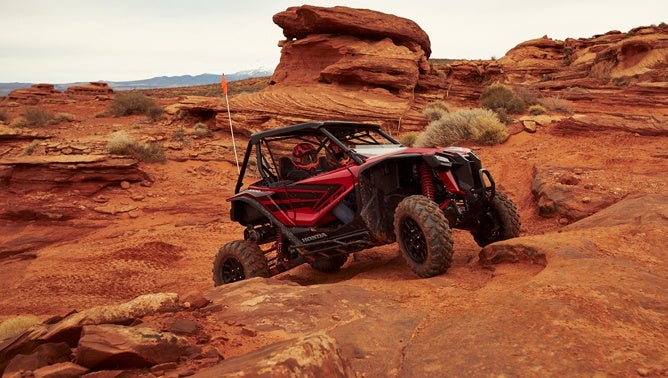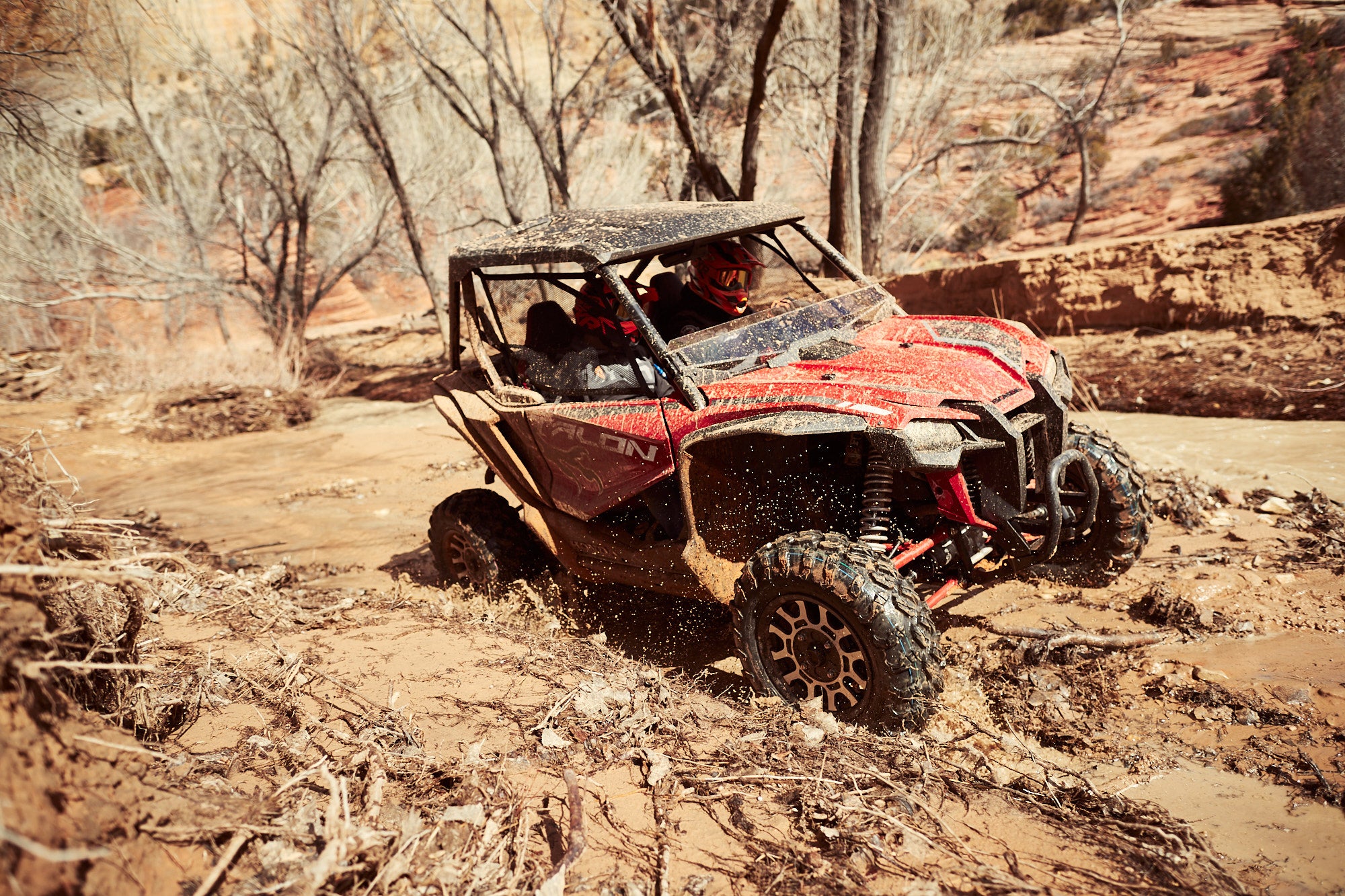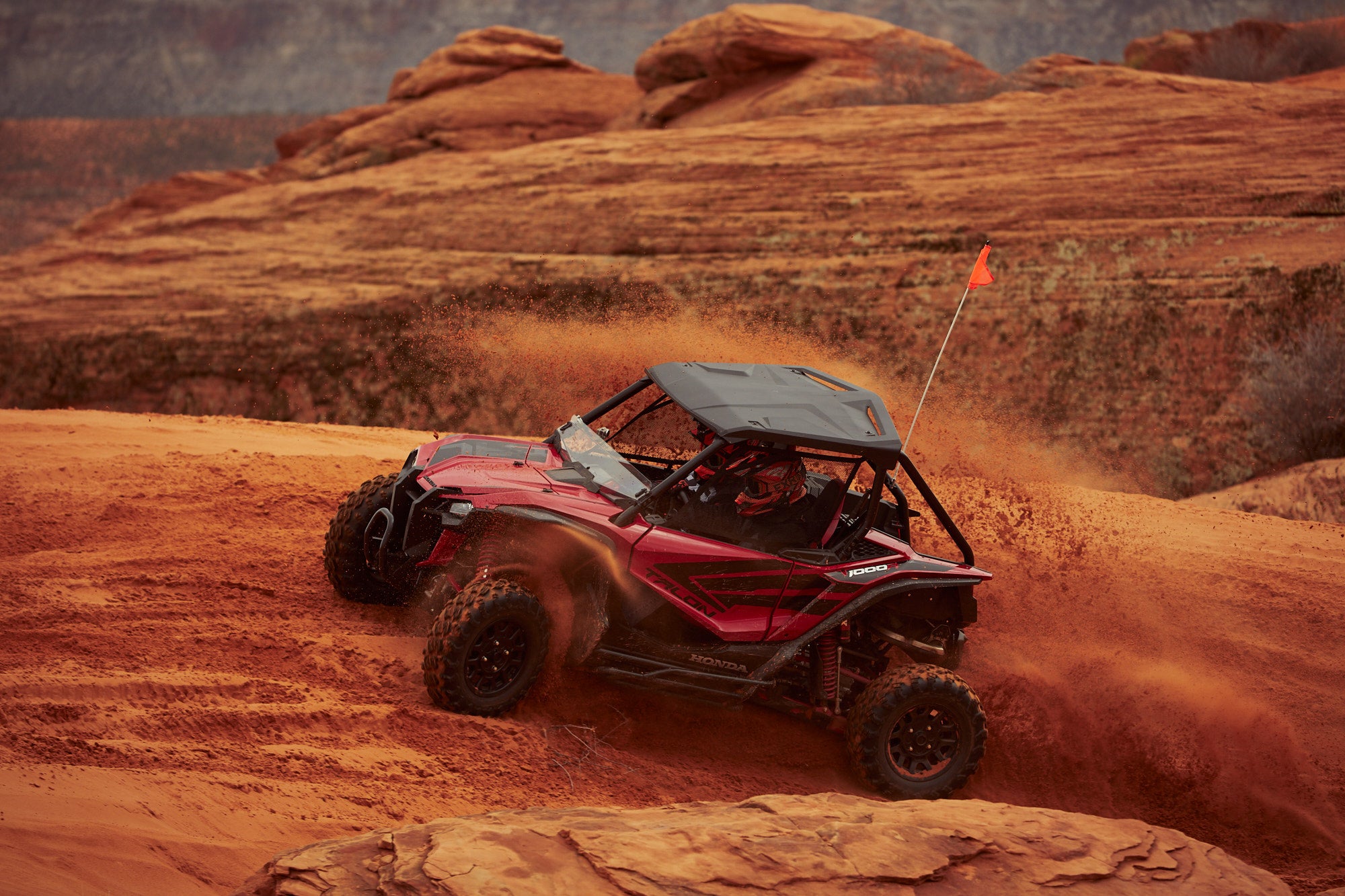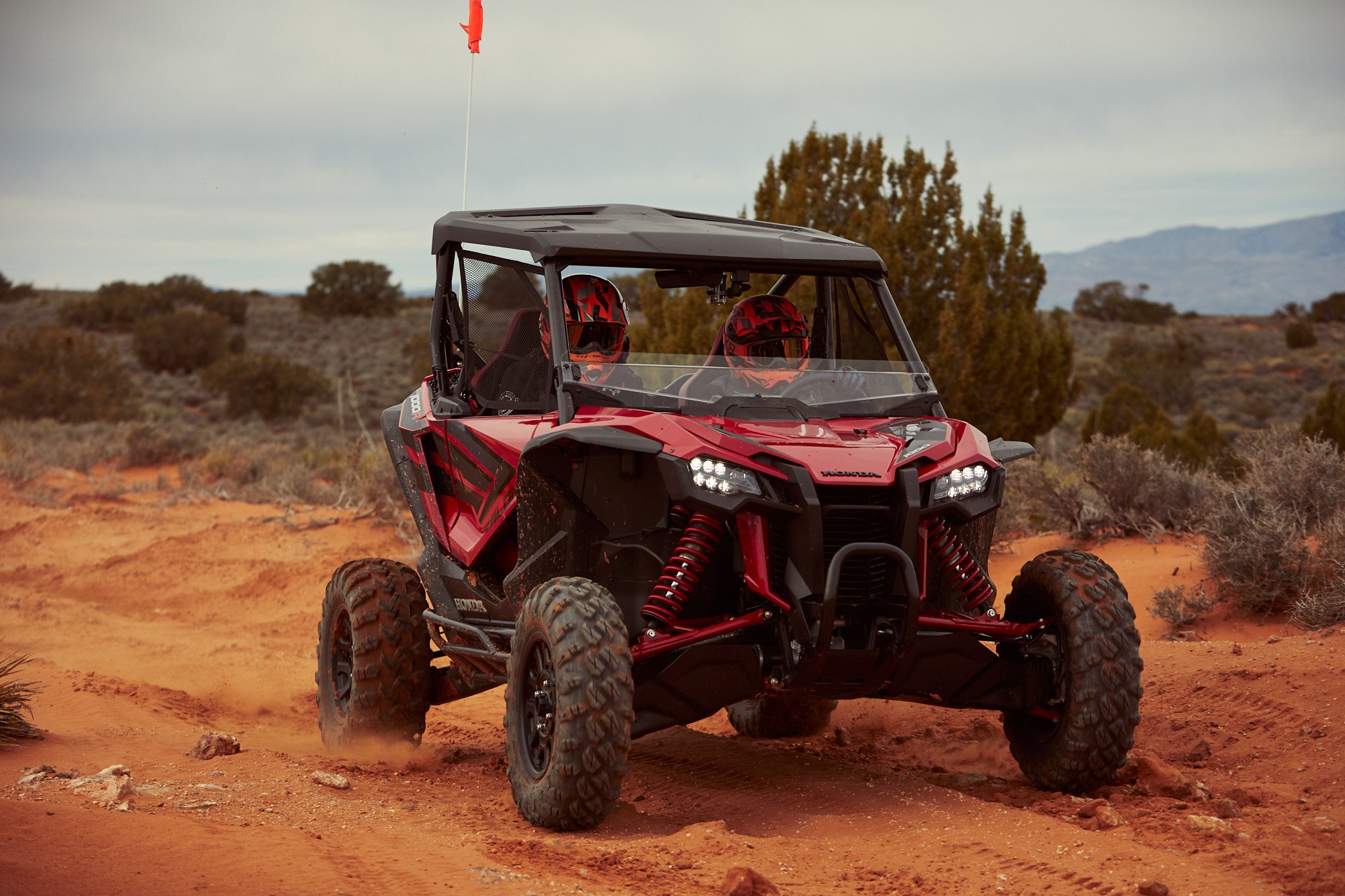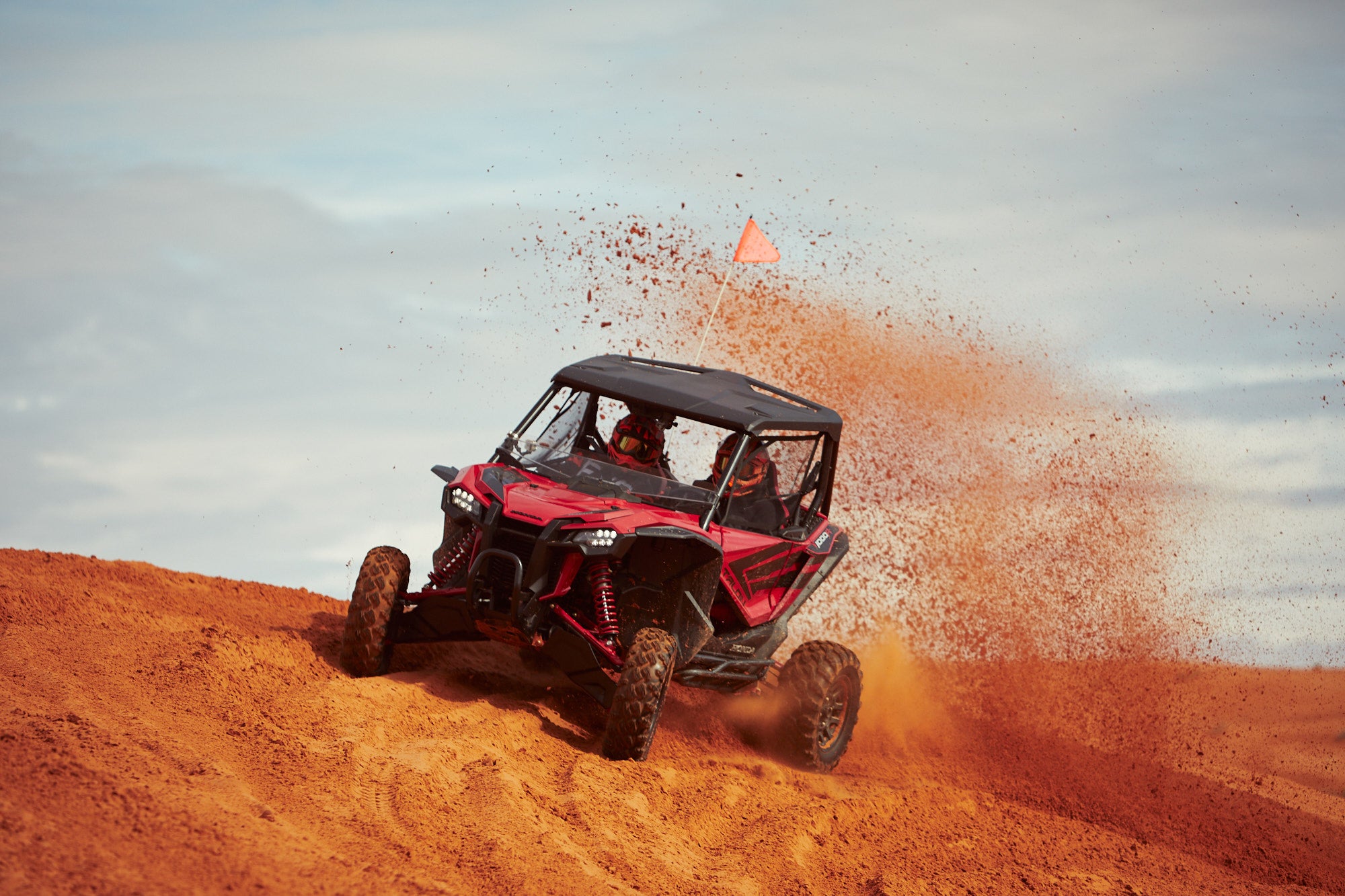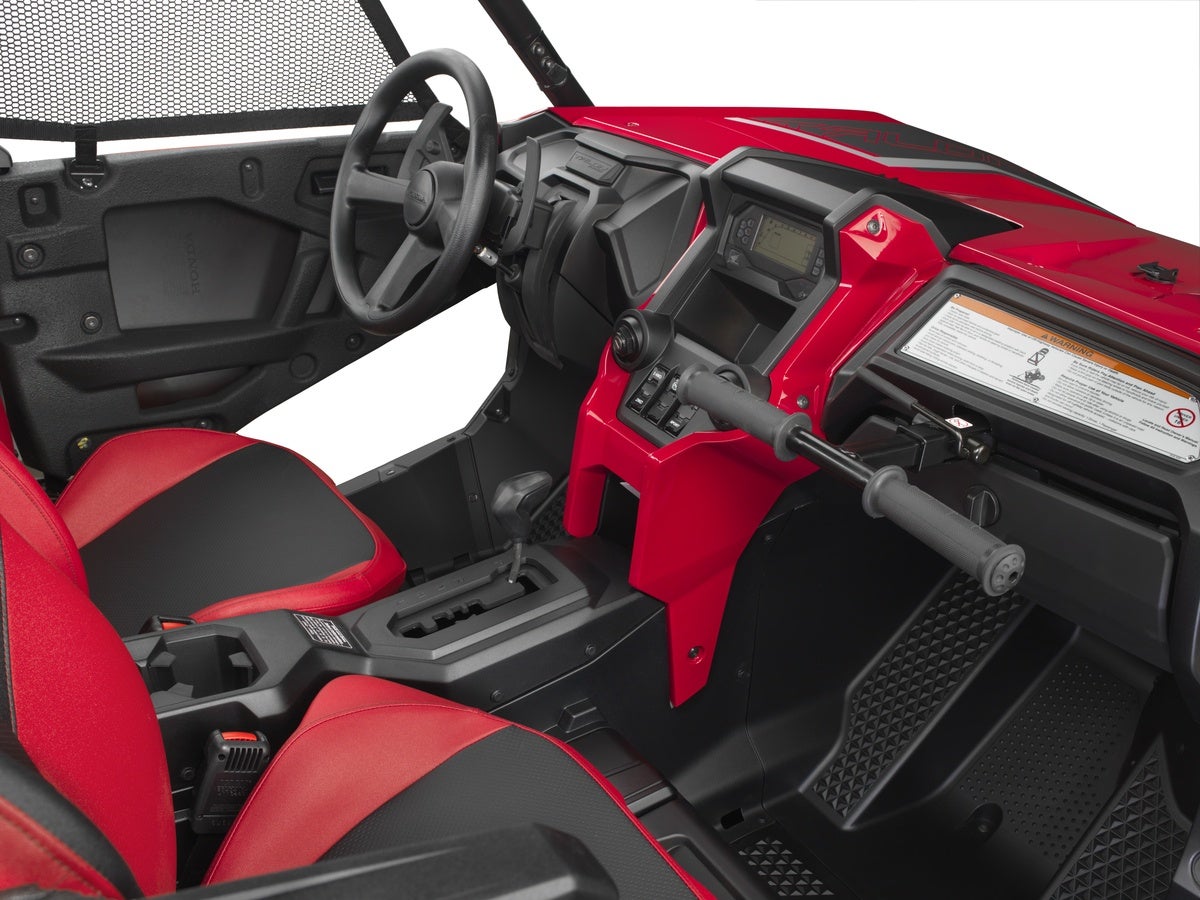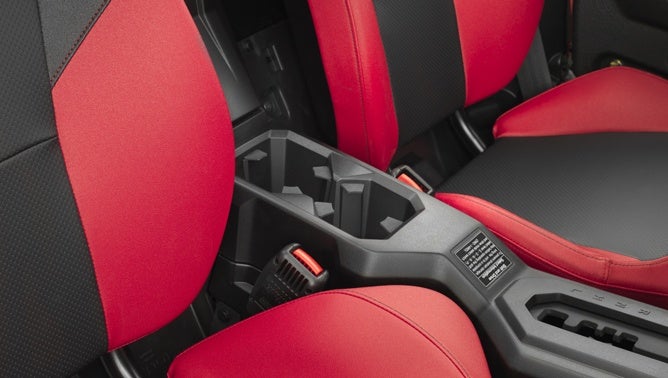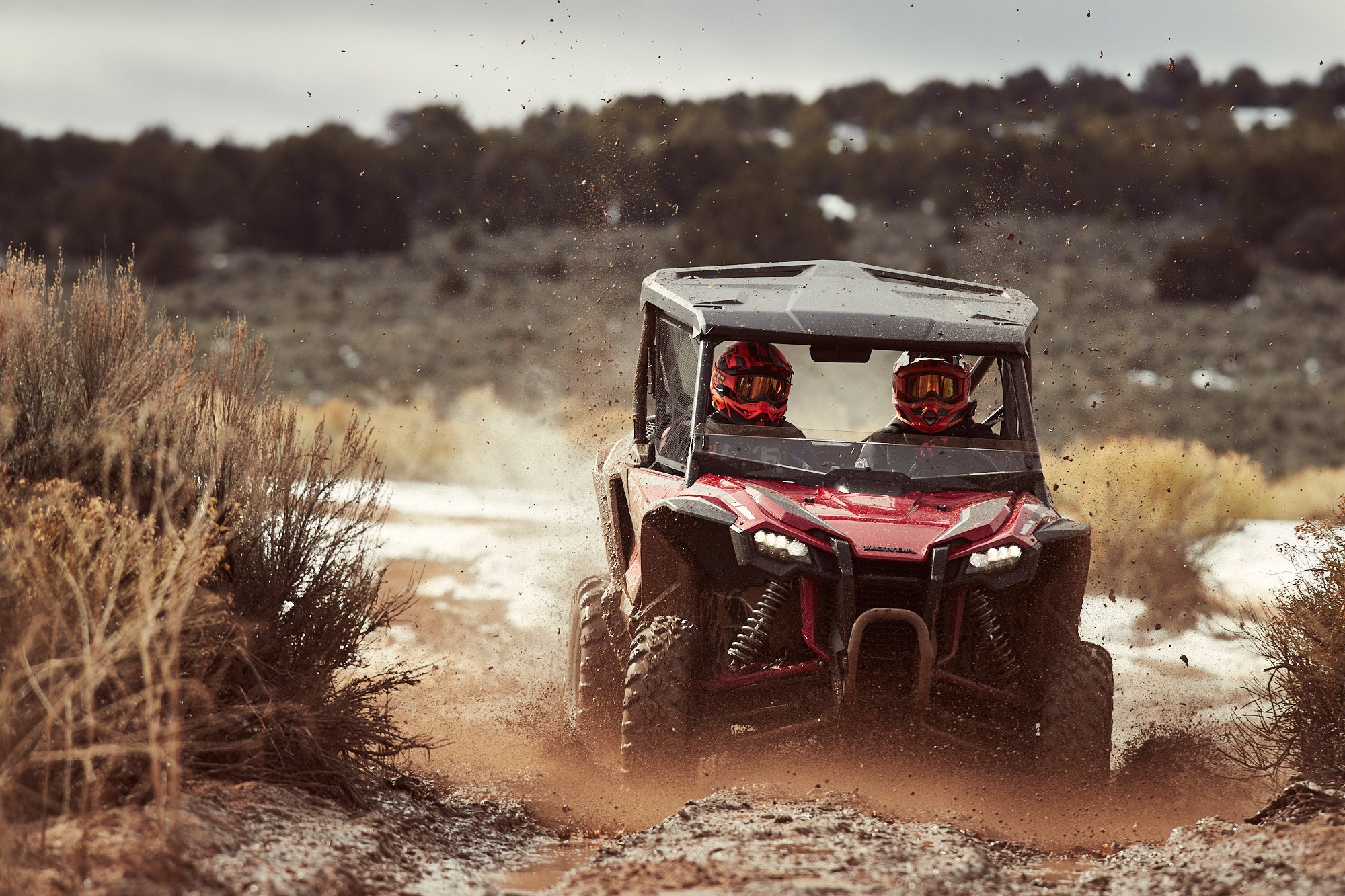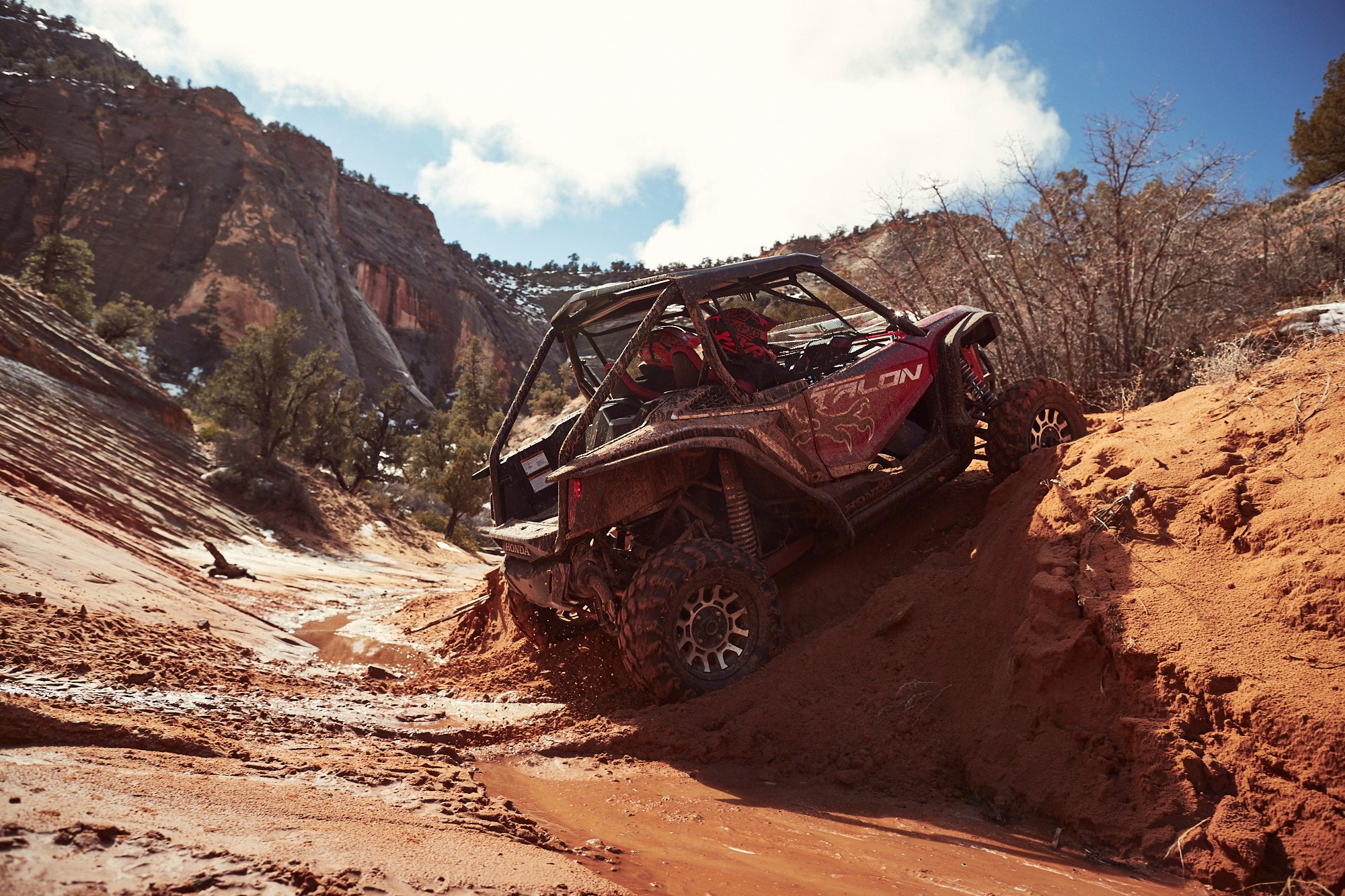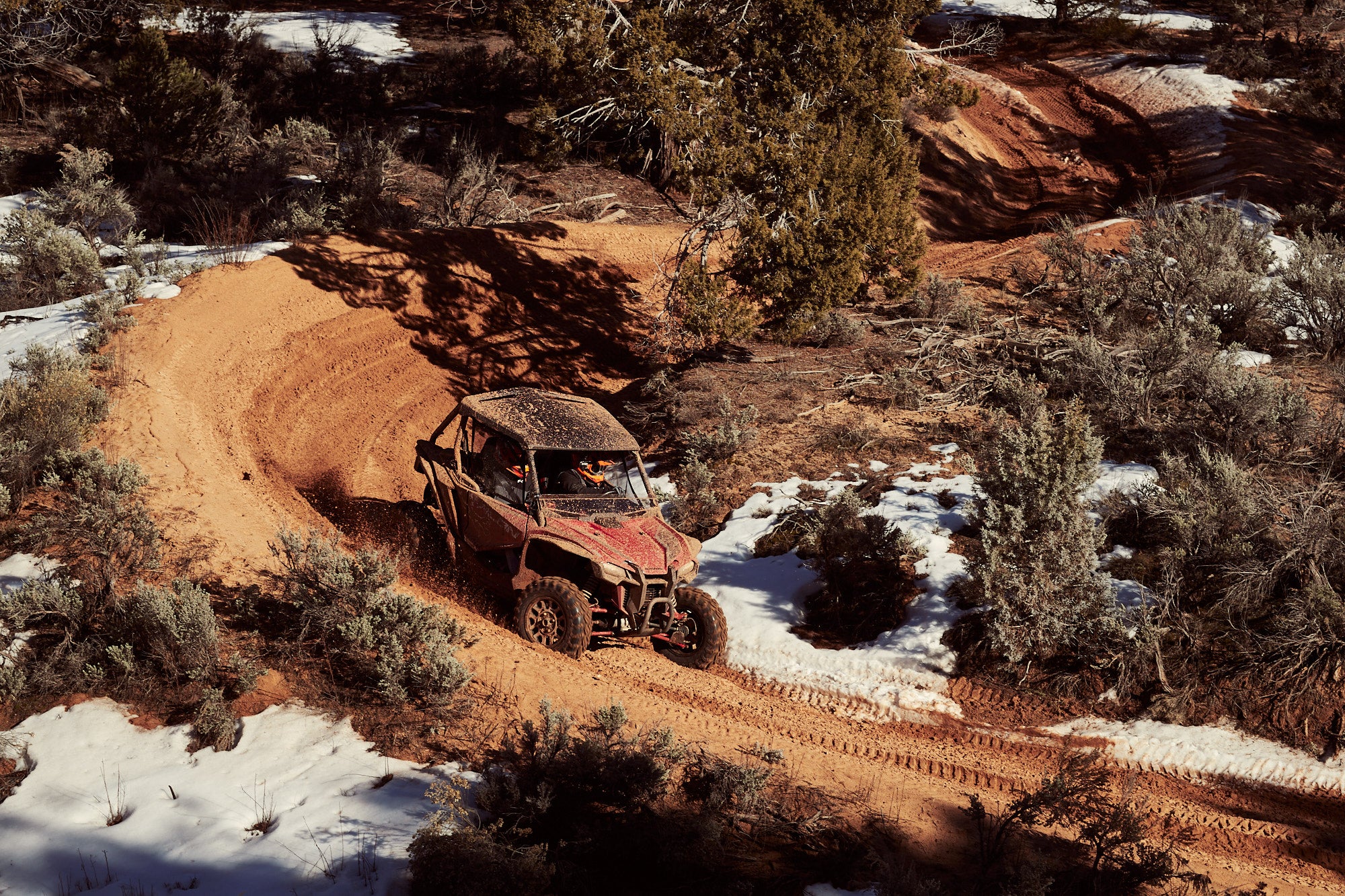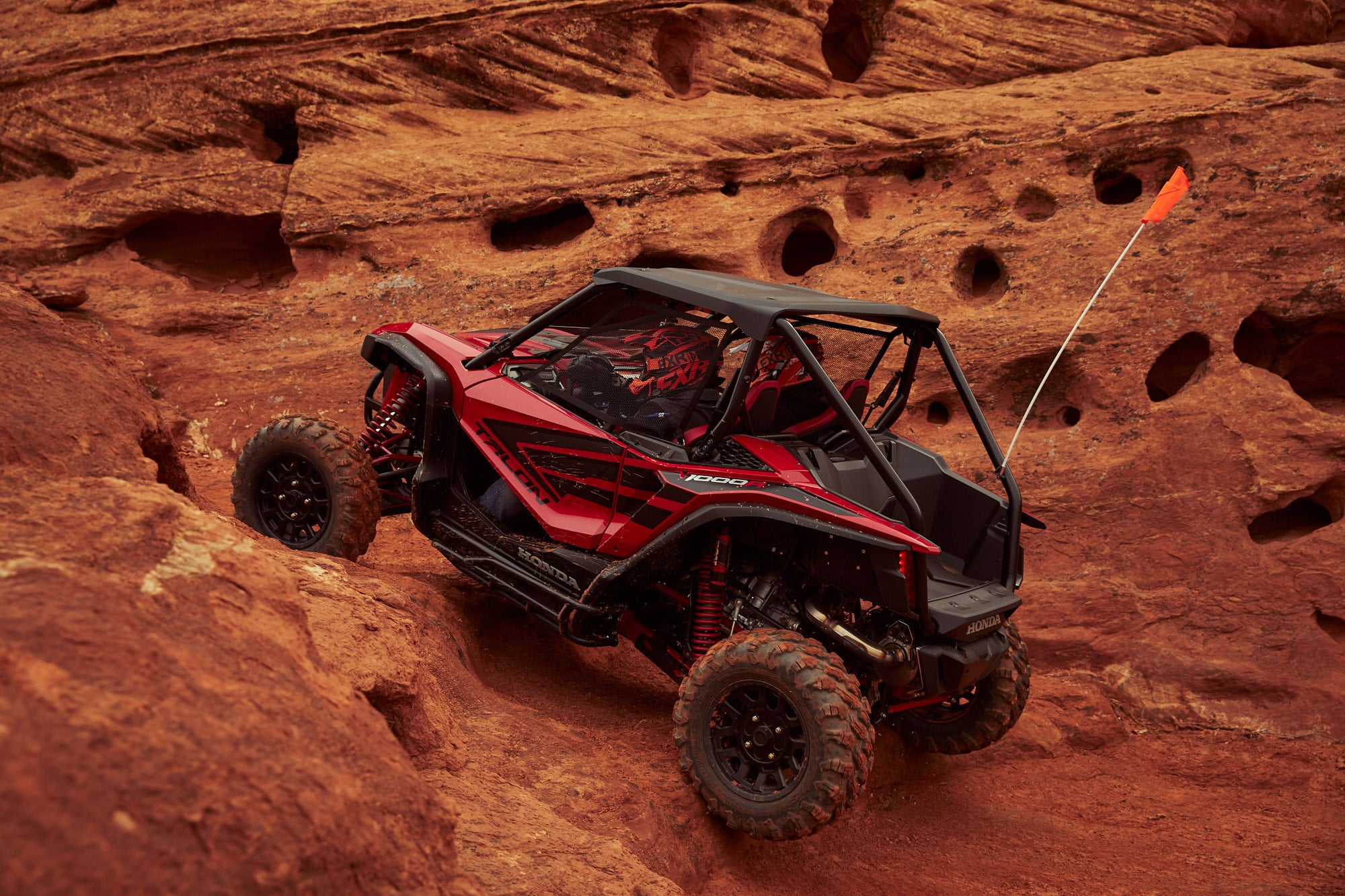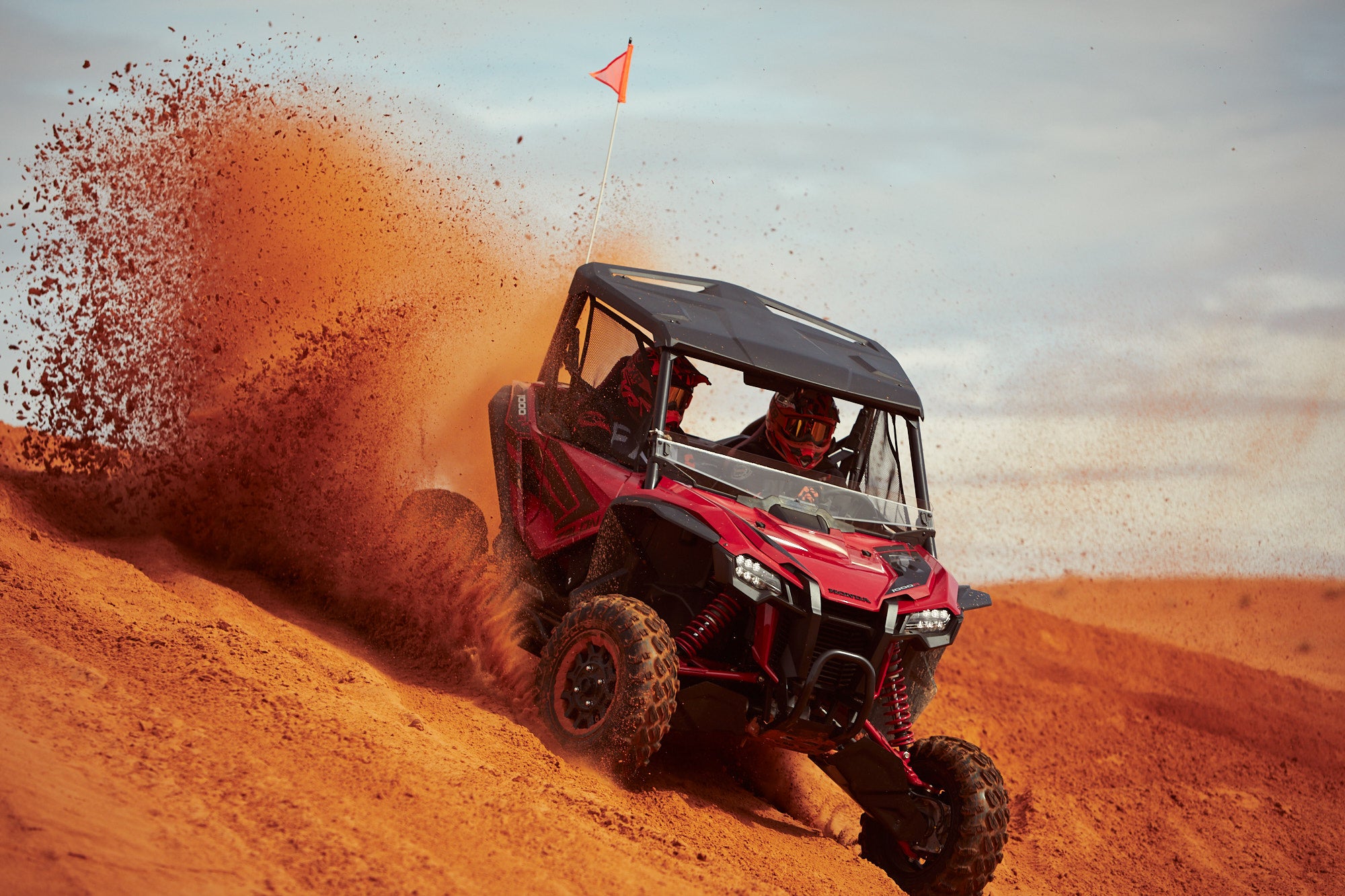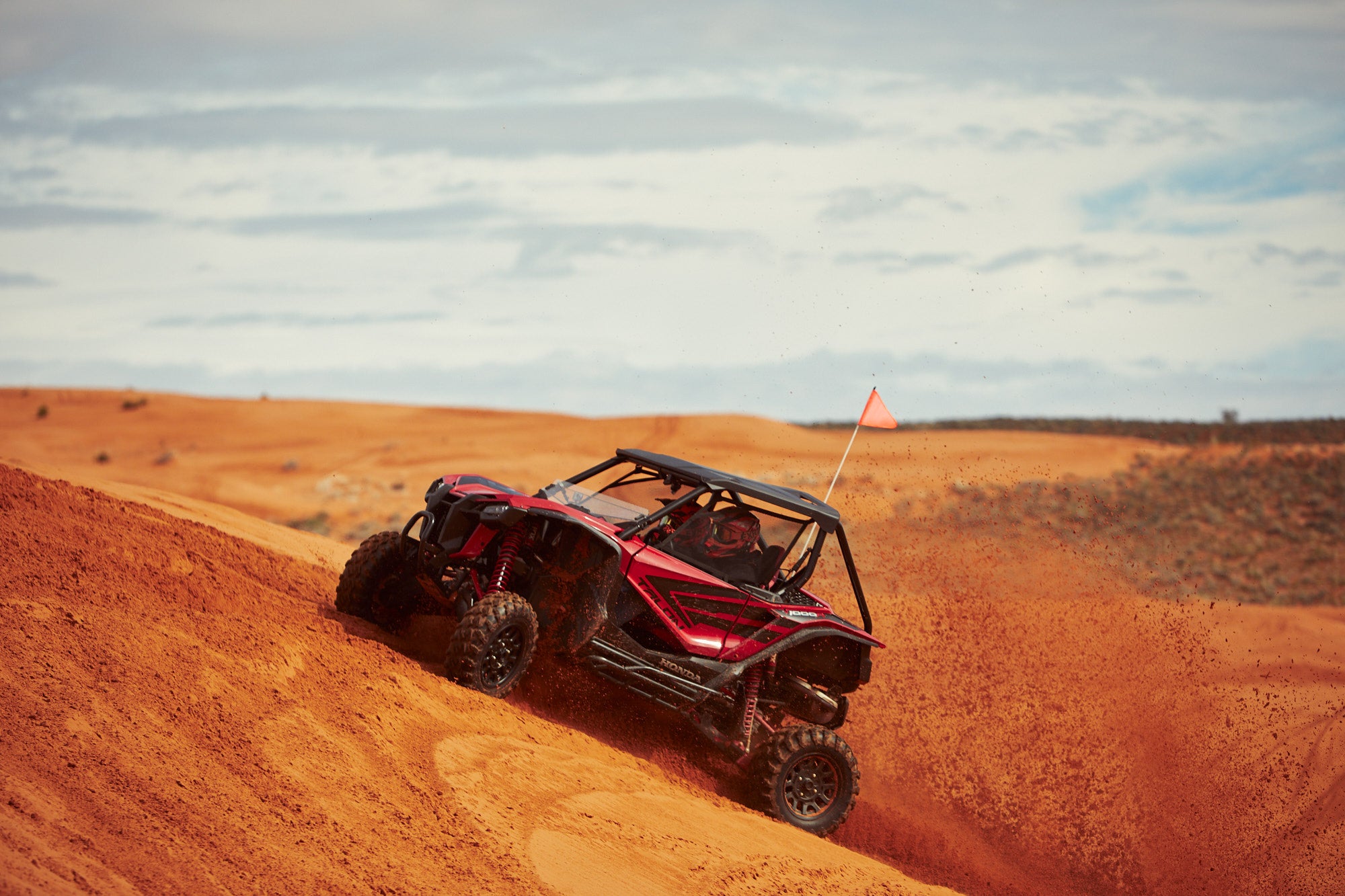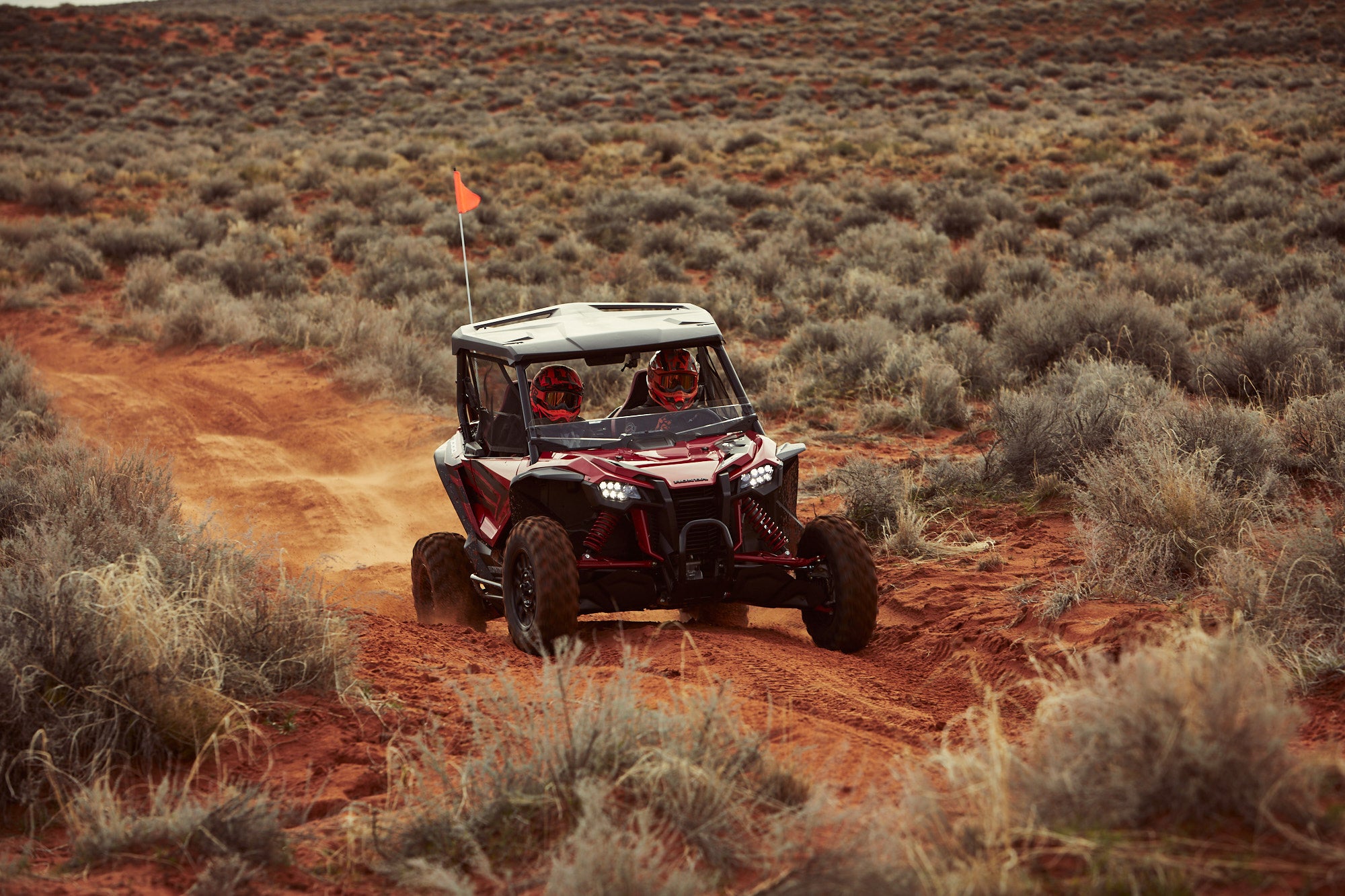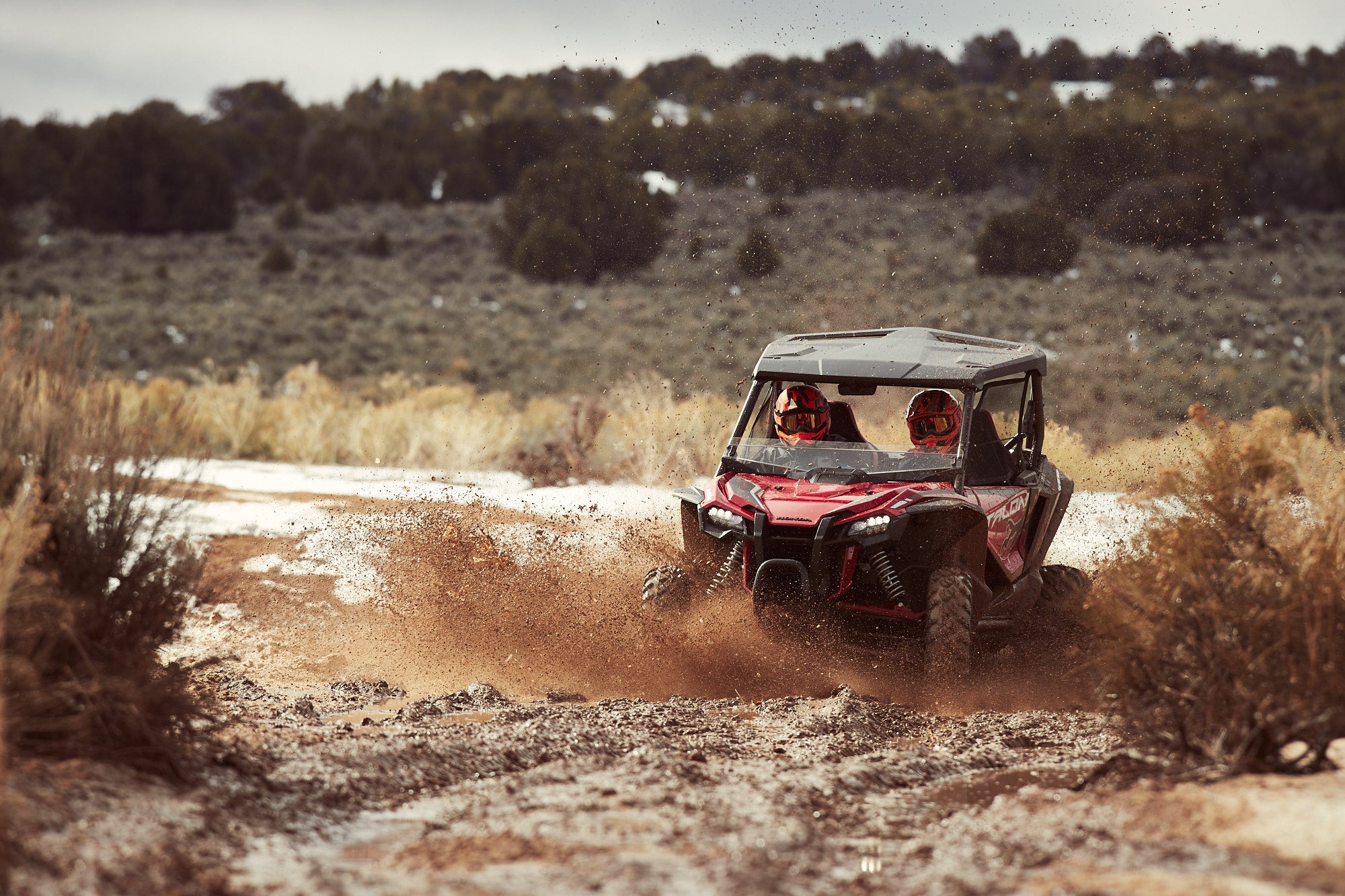Let me just start out by saying what everyone else is thinking about Honda right now – it’s been a long time coming for them to unleash a sport side-by-side to the market. Luckily for us, Honda knows this and they feel the same way.
The engineers were quick to tell us that they have spent years upon years on the Talon doing their best to perfect their first sport UTV in every way that they felt necessary. But, even with a company as big as Honda and with so many resources in their R&D arsenal, I’m left here wondering if they could really pull off a home run with their first sport model? That’s what we’re here to figure out.
Honda’s approach to the sport side-by-side market was unlike any other manufacturer in the industry. They identified the fact that they wanted to jump into the 64” wide pure sport category right from the get-go, but they couldn’t quite achieve the driving dynamics they were looking for with just one vehicle. So, they continued their development of a true 64” version, which would be more trail oriented with a focus on technical handling and trail capability. In addition, they set performance benchmarks for a vehicle with more suspension travel that would be better for the vast desert terrain that streaks across the Western U.S.
In other words, the goal was to produce a vehicle with over 20” of rear suspension travel that would help it navigate deep whoop sections and massive rock climbs. The only way to make this happen was to make a wider version of the code-named Talon. Honda’s development team and engineers were now cohesively working on two vehicles instead of one. These two would both meet the market needs and satisfy their born-and-bred performance desires.
Thus, here we are here today with 2 sport side-by-side vehicles from Honda at your local dealer – the Talon 1000X is the 64” version and the Talon 1000R is a 68.4” wide model. Besides the suspension setups, both models share almost all features, including the same one-piece rigid chassis, tire/wheel setup, and interior bits.
Honda Talon: The Basics
Both Talons are based on a two-seat platform underpinned by the aforementioned one-piece chassis. Wheelbase stands at 92.7” for the R and 87.6” for the X, and the overall length measures out to be 123.9” for both. For all of you with a 12’ garage in your toy hauler, the Honda Talon will fit and possibly have enough room for a dirt bike in front or behind it.
The powertrain platform is loosely based on the Pioneer 1000 with the 999cc parallel twin engine and six-speed automatic/manual Dual Clutch Transmission (DCT) combination. However, this does not mean that it is the same powerplant setup in terms of performance. Honda knew that a rebadged Pioneer engine/tranny combo wasn’t going to deliver the sporty behavior that a pure sport side-by-side needed. So, they changed up the firing order in the engine to 270 degrees to give it snappier performance throughout the entire rev range. Plus, they quickened the shifts by as much as 50% to make the DCT sportier and more performance-oriented.
The one thing that hasn’t changed is this transmission includes both manual and fully automatic modes. The automatic mode is the default setting every time you start the Talon. If you want a bit more of a sporty feeling, you can put it in automatic Sport mode for faster shifts and more aggressive downshifts – and by aggressive I mean that it downshifts at higher RPMs to help you carry speed around corners and keep the revs up. For those who want to enjoy a manual shift experience, a full manual mode is activated via the dash-mounted rocker switch (just like Sport, automatic mode). This allows you complete control over the entire powertrain system with the steering wheel-mounted paddle shifters.
ALSO SEE: Buyers Guide: The 10 Best Polaris RZR Accessories and Upgrades
For those of you reading this who have criticized the Yamaha YXZ1000R for having only a manual transmission option, the Honda Talon gives you the best of both worlds with a fully automatic mode and a manual transmission. Both vehicles have paddle shifters to shift (on the SS versions of the Yamaha…) and a very similar chassis setup. If you want that third pedal on the floor, then the Yamaha is still the only choice on the market.
Like the Pioneer 1000 LE model, i4WD comes to both models of the Talon. This 2WD/4WD system is button-activated on the interior dashboard (the rear differential is always locked). The i4WD is essentially a traction control system for the front wheels. When it’s engaged, the system detects any slip from either of the front wheels. If one wheel is slipping with less traction on loose terrain (or it’s in the air), the brakes are automatically applied on that wheel so the power is directed to the wheel with more traction. Thus, theoretically, you always have the wheel with the most traction having the most power being applied through it. Novel idea, no doubt.
Both interiors are exactly the same and feature more refinement than most vehicles on the market. For starters, the sun top is a standard feature on all Talon models – THANK YOU, Honda! The seats are well bolstered and very well made, keeping us comfortable and securely in place for a full 2 days of riding. Plus, they have cutouts ready for 4-point harnesses. Like most other side-by-sides on the market, I still wonder why Honda didn’t just put 4-point seat belts in from the factory. All of the controls are easy to reach for the driver, and I really appreciate the automotive-style doors on both Talon models. While I’d still like to see a full half door from the factory, these have to be the best quarter doors on the market with no rattling, a secure latch that is easy to get to from both inside and outside the vehicle, and a great feel on the inside and outside. Honda quality shines through and through with the interior even in the roughest, “it should be rattling but it’s not” terrain.
Storage options are good on the inside of the Talon with a large-ish glovebox on the passenger side right below the infinitely adjustable passenger grab handle. In the center section of the dash, we find the generic instrument cluster that gives you all the necessary readouts that you would find useful – engine RPM and temperature (although why isn’t the actual engine temperature displayed?!), speed, trip meter, odometer, etc. Two open storage areas are found below the cluster with a 12V outlet for charging convenience. I do tend to enjoy instrument clusters attached to the steering column these days because they are within your line of sight, but this one does an OK job of giving the driver the information they need at a quick glance. I would still rather have it on the column, though.
Both Talon models come with 28” tires mounted on non-beadlock 15” aluminum wheels. Yes, that’s not a typo… 15” wheels are used to clear the pivots and attachments on the front/rear knuckles. For those wondering, the bolt pattern is the same as the Can-Am side-by-side lineup.
That pretty much wraps up the similarities between both machines, so we’ll break down the differences (only 1 really…) and, most importantly, how each of them drives!
Honda Talon 1000X
The major and really only difference between the X and R versions of the Talon lies in the suspension components. This X version has a 3-link trailing arm setup in the rear with Fox Podium 2.0 shocks (with Quick Switch 3 compression adjusters). The rear has 15.1” inches of travel and the front has 14.6” inches of travel. The front is suspended with Fox Podium 2.0 shocks again (with Quick Switch 3 compression adjusters) but with traditional dual a-arms.
With a compact dual rate spring setup on the rear shocks, the suspension almost acts as a single spring setup. This is good in ways, i.e. good bottom resistance and better direct handling characteristics, but it also takes away a bit of ride quality in the washboard and small chop. As such, drivers will feel that the slow speed ride quality suffers slighting with this setup as it is a bit harsh over the washboard terrain. Like most other sport UTVs these days, the ride smooths out over 35 mph, but we appreciate a bit more slow speed ride quality, too.
When the going gets faster, this Fox suspension setup really comes alive. Bottom resistance is superb with these shocks, even with the QS3 adjustment in setting 2, which turned out to be my favorite drive setting. 3 was a bit harsh, and 1 just didn’t make the ride that much smoother in most terrains. Overall, a bit of spring tuning would be helpful for those looking to even out the ride quality with a bit more slow speed smoothness.
The 1000X handles much like a dirt bike or sport quad – if you’re used to those vehicles then you’ll really enjoy the sporty driving dynamics. When driving the Talon, you can literally use the terrain to bunny hop the back suspension into corners, easily setting yourself up for the tight twisties and bermed corners. When I say that the Talon rails corners, it really does rail corners with precision. The way the chassis is set up to drive, it’s extremely fun to toss the X around tight trails where handling prowess is a top priority. Drivers will feel confident in the 1000X knowing that where you place it is where it’s going to go.
Despite the excellent handling characteristics through the tight twisty trails, the Talon 1000X tracks with a bit of uneasiness when on straight, sandy trails. Part of this has to do with the tire selection on this vehicle – we would have much rather seen a 29” or 30” tire mounted to the 15” wheel to give this vehicle a bit more sidewall for better traction and stability. Otherwise, this 1000X handles with the prowess and agility that you would expect from a Honda performance machine. It is truly comfortable fro all-all-day excursions and is a blast to drive.
ALSO SEE: Honda Talon vs the Rest: How Does It Stack Up to Polaris, Textron, Yamaha and Can-Am?
Honda Talon 1000R
Instead of a 3-link rear setup, the 1000R has a 4+ link rear suspension setup with dual rate springs (crossover adjustment, too) and larger Fox Podium 2.5 shocks (again with Quick Switch 3 compression adjusters on both front and rear shocks). Combined with the front a-arm configuration, which has Fox Podium 2.5 shocks with dual rate springs attached, the overall width of the R-model sits at 68.4” and the wheelbase increases by 5.1” over the 1000X to 92.7”.
You would think that the increase in width and wheelbase would give the driver and passenger a more stable ride and more capable suspension action, especially with the dual rate setup (keep in mind, the 1000R has same 28” tire/15” wheel setup as the 1000X model). Jumping into the 1000R cockpit, this theory rings completely true. The R-model not only tracks straighter and with more confidence than the X model, but it is more confidence-inspiring on straight line roads and whooped out sections when you drive it.
The suspension soaks up slow speed obstacles and washboard better than the X, too, and the high speed is more controlled in the R model. It’s not that the X model is uncontrollable, it’s just more of a one-dimensional driving experience. Whereas, the R model has multiple dimensions in its handling characteristics. You can still rail berms and know exactly where the vehicle will track like the X, but you can also pound through 2’-3’ whoops without bottoming out the suspension. Overall, the increase suspension and chassis prowess make for a more exhilarating driving experience in the R.
And that really sums this up, simple and easy. The 1000R is more exhilarating than the X in many ways. Whether you’re flying through whoops in 4th gear, rock crawling at slow speeds, or just cruising around camp in auto mode with your kiddos strapped into the passenger seat. It handles everything you throw at it a bit better with more handling composure and predictability than the X model.
ALSO SEE: Quad Special! Riding Yamaha’s SE 4-Wheeled Thrill Machines
Just like the 1000X, the 1000R’s interior is very comfortable and well laid out with all of the switches in easy to reach locations. With the higher speeds that the Talon 1000R can achieve, I really wish it had 4-point harnesses in it from the factory, but the seats still do a good job at holding you in with the long bottom seat cushion, easy seat sliders, and well-bolstered sides. These could definitely be in the running for best stock seats in the industry. The center console storage compartments (uncovered) are very welcomed as they can easily hold snacks, gloves, and assorted items.
After testing, we found that the rear cargo area was plenty big enough for a cooler and all of our gear. Multiple tie-down points make securing cargo a cinch, and the high sides to the cargo bed are much appreciated for keeping everything contained.
The Verdict: Honda Talon Review
One thing that I didn’t mention above is the fact that the i4WD system works better than I ever thought it could on both Talon models, especially when crawling through tight, technical terrain and through rock climbs on the slick rock in Utah. It not only directs power to the wheel with more traction, but it does so smoothly and effortlessly. I hope to be able to test it in more big rock sections down the road, but so far it works very well. We’ll need more testing time in the rocks and muddy terrain to really determine if this system works as well as a fully locking front differential.
Also, there are a couple of funny things going on with the interior. The power steering on both of these vehicles is very light and doesn’t seem to ramp up as the going gets faster. I like the light feel at slow speeds for maneuverability, but a bit more resistance would be welcomed at higher speeds. It’s just a bit numb all around. And, to make matters more interesting, it could use about a 1/4 turn taken out of the rack overall – this would make the steering a bit quicker for the tight, technical sections and when quick steering corrections are needed in high-speed terrain.
The other “funny” thing is that the foot pedals are well suited to two-foot drivers, but not so much for one-footed drivers. The throw from the gas to the brake is much farther than it needs to be. Again, this isn’t bad since the brake pedal sits close to the left footrest so a two-footed driver has an easy throw, but you notice the gap with one footed driving.
Both machines are available with a huge assortment of accessories right from the dealer. Many of the accessories, such as the winch kit and various interior storage bags, are great additions to these already stout vehicles, but they will bump up the asking prices, which start at $19,999 MSRP for the 1000X and $20,999 MSRP for the 1000R.
ALSO SEE: Polaris RZR XP Turbo S Review: Is There a New King of the 2-Seat Turbo UTV Class?
Overall, both the Talon models are an absolute blast to drive. I’ve picked out many of the positives in this vehicle because it truly a great sport side-by-side, especially because it’s the first from Honda. They nailed it, big time. Yes, there are things they need to adjust and fix in the coming years, but these are all easily done. As a whole, Honda got the Talon right, and it is sure to be a hot seller now and in the coming years. We know that the Talon will last with Honda engineering and quality backing it up, and we also know that the Talon is an absolute blast to drive, no matter which one you choose.
Discuss this article on our Honda Talon Forum
Photos By: Drew Ruiz
